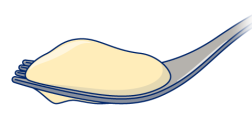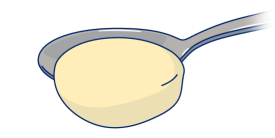This information explains what a level 4 pureed diet is and how to follow it. It explains how to test your food’s thickness. It also lists foods to include and avoid while following this diet.
What is a level 4 pureed diet?
A level 4 pureed (pure-AYD) diet is when you only eat foods you do not need to bite or chew. While you’re following this diet, you will make your foods smooth and moist before eating them. This makes them easier to swallow.
Food that is pureed:
- Is smooth, soft, and moist.
- Is usually eaten with a spoon.
- Holds its shape on a spoon.
- Flows very slowly.
- Cannot be sucked through a straw.
How can I puree my food while following a level 4 pureed diet?
You can use a blender, food processor, or other kitchen item to make your foods smooth. For some ideas, read the “Kitchen items to help you make food” section of this resource.
Add liquid to the blender or food processer to make your foods smooth, soft, moist, and lump free. You can add:
- Water
- Broth
- Gravies
- Sauces
- Juice
- Milk
- Yogurt
Add just enough liquid so that your food is smooth but not too watery or runny. Make sure to check the thickness of your food before you eat it. Read the “How can I make sure my food is the right thickness?” to learn how.
Why do I need to follow a level 4 pureed diet?
You may need to follow a pureed diet if you:
- Have dysphagia (dis-FAY-jee-uh). Dysphagia is when you have trouble swallowing.
- Had mouth surgery.
- Have lost feeling in parts of your mouth, such as your lips and tongue.
- Have trouble moving parts of your mouth.
How can I make sure my food is the right thickness and texture?
You can check your food’s thickness and texture by doing a fork drip test and spoon tilt test. Follow the steps in this section.
Your food’s texture can change based on its temperature and how you cooked it. Test your food right before you start eating it to make sure it’s the right thickness.
Fork drip test
- Pick up some of your food with a fork.
- Check if any food falls through the prongs of the fork.
Level 4 pureed foods should sit on top of the fork with very little or no drip through the fork (see Figure 1). A small amount may drop, but the food should not drip without stopping.

Figure 1. Fork drip test
Spoon tilt test
- Pick up some of your food with a spoon. Your food should hold its shape on the spoon.
- Tilt your spoon slightly to the side.
- Check if any food slides off.
Your food should easily slide off (see Figure 2). It’s OK if you need to gently flick the spoon to get the food to fall off. Your food is too thick if it sticks to the spoon or does not fall off the tilted spoon.

Figure 2. Spoon tilt test
What can I eat on a level 4 pureed diet?
Here are some foods you can eat while following this diet. We also list some foods you should avoid.
These tables are not a complete list of foods you can eat on this diet. Other foods may be OK to eat if you test them and they are the right size and texture.
If you have trouble swallowing liquids, your speech language pathologist may recommend you thicken your liquids. If you need to thicken liquids, read About Thickening Liquids.
Milk and dairy
| Milk and dairy to include | Milk and dairy to avoid |
|---|---|
|
|
Proteins
| Proteins to include | Proteins to avoid |
|---|---|
|
|
Vegetables
| Vegetables to include | Vegetables to avoid |
|---|---|
|
|
Fruits
| Fruits to include | Fruits to avoid |
|---|---|
|
|
Starches
| Starches to include | Starches to avoid |
|---|---|
|
|
Fats
| Fats to include | Fats to avoid |
|---|---|
|
|
Soups
| Soups to include | Soups to avoid |
|---|---|
|
|
Sweets and desserts
| Sweets and desserts to include | Sweets and desserts to avoid |
|---|---|
|
|
Other
| Other things to include | Other things to avoid |
|---|---|
|
|
Sample menu for a level 4 pureed diet
Use this sample menu to get ideas for making your own level 4 pureed diet meals.
| Level 4 pureed diet menu | |
|---|---|
| Breakfast |
|
| Mid-morning snack |
|
| Lunch |
|
| Mid-afternoon snack |
|
| Dinner |
|
| Evening snack |
|
How to plan your meals on a level 4 pureed diet
Changing your eating habits can be hard. It’s best to plan your meals ahead of time. This can help you make sure you have enough of the right foods to eat at mealtimes.
Here are some questions to think about when planning your meals:
- Where will you be eating? Will you be eating at home, a restaurant, work, or someone else’s house?
- If you’re eating at a restaurant, can you call ahead and ask for special meals?
- Will you have a kitchen and refrigerator available? Can you boil water? Can you microwave? Can you use a blender or food processor?
- Can you carry a thermos with a meal already made and ready to eat? A thermos is a container that keeps a drink or other fluid hot or cold with food.
Tips for eating at home
You can puree many different foods by putting them in a blender with some liquid. You can use water, broth, gravies, sauces, juice, milk, or yogurt. Add liquid until the food is the right texture and thickness.
Kitchen items to help you make food
Here are some items that can help you make foods at home.
-
Blender: Use a blender for all types of foods, including meats, vegetables, and fruits. You may have to add liquid to make the food the right texture. Blenders are great for soups and shakes.
- The Magic Bullet® and Nutribullet® are small blenders that do not take up a lot of space.
- The Vitamix® and Ninja® are bigger blenders that can puree a larger portion of food.
- Hand-held blender: Use a hand-held blender to quickly puree your favorite soups right in the pot. It can also be used to soften well-cooked foods in a small bowl for 1 or 2 servings.
- Food processor: Food processors are useful for shredding, slicing, chopping, and blending foods. They come in different sizes. If you often make just 1 portion of food, buy a small food processor.
- Household mesh strainer or sieve: Use this to strain fruits and vegetables, but not meats. They are inexpensive, good to make 1 serving, and do not need electricity. But using a strainer can take more time than using the other kitchen items listed here.
Tips for eating at restaurants
Eat at restaurants offering different types of foods and that will adjust for people on special diets. Many places will puree or make foods for your needs. Call ahead and speak to a manager or chef. You may be surprised at how helpful they will be.
Tips for eating away from home
It’s also possible to eat away from home, such as at work or at a friend’s house. Here are some tips for taking food with you while you’re away from home:
- Bring a food grinder or small food processor. If you need electricity, make sure it’s available where you’re going.
- Buy a thermos. Make soup or hot cereal and carry it with you.
- Ask if there is a microwave where you’re going. You can make food at home and freeze it in single-serving, microwave-safe containers or Zip-Loc® bags. Bring the food with you in an insulated (keeps food cold) pack and heat it when you want to eat.
- Freeze soups or pureed foods in ice cube trays. Cover the tray with foil or plastic wrap to prevent freezer burn. When you’re hungry, use 2 or 3 cubes for a small meal or snack, or more cubes for a larger meal.
Tips for adding more calories to your diet
- Eat small meals 6 to 8 times a day instead of 3 main meals.
- Add 2 to 4 tablespoons of canned coconut milk or cream to smoothies, shakes, cereals, and yogurts for extra calories. You can also add it to pureed dishes for extra calories, flavor, and moisture.
- Choose creamy soups rather than soups with clear broths.
- Have puddings and custards rather than gelatin desserts, such as Jell-O.
- Add sauces, gravies, butter, or extra vegetable oil to your meals.
- Drink fruit shakes or fruit smoothies made with yogurt or ice cream.
- Make ice cubes from milk or fruit nectar. Use these high-calorie ice cubes in smoothies or to keep your shakes cold. As they melt, they will add calories to your drinks.
- Drink high-calorie drinks, such as whole milk, milkshakes, or pasteurized eggnog.
- Use oral nutrition supplements, such as Ensure® or Boost®, as a nutritious, high-calorie liquid base in smoothies and milkshakes.
- Add honey to smoothies, tea, yogurt, hot cereals, shakes, or ice cream.
- Add sour cream, half and half, heavy cream, or whole milk to your foods. You can add them to mashed potatoes, sauces, gravies, cereals, soups, and casseroles.
- Add avocado to dishes or smoothies and blend.
- Blend nut butters, such as peanut butter, into shakes and smoothies.
Tips for adding more protein to your diet
- Add pureed tofu to cooked vegetables, soups, or smoothies. You can also eat tofu instead of chicken or meat if you’re having trouble eating animal proteins.
- Add pureed cooked eggs to your soups, broths, and cooked vegetables.
- Use plain full-fat Greek yogurt in smoothies, cream sauces, or wherever you would use sour cream.
- Use a plain protein powder, such as whey or pea protein powder, in liquids and shakes.
- Add full-fat ricotta cheese to moisten a dish and add calories and protein.
- Add cottage cheese to smoothies or pureed fruit.
Contact information
If you have questions or want to make an appointment with a clinical dietitian nutritionist, call 212-639-7312.
